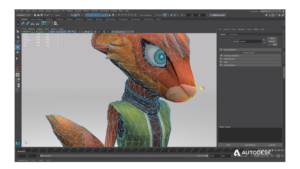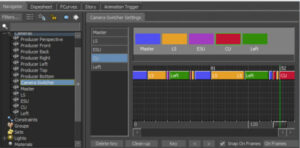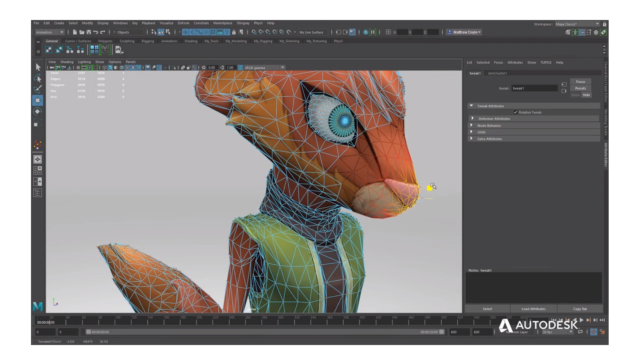The new release features stability, bug fixes, and animation updates.
Autodesk has released Maya 2019, Maya LT 2019, MotionBuilder 2019, and Mudbox 2019. The company says it has concentrated primarily on bug fixes and stability.
The new Cached Playback feature in Maya 2019 allows artists to review their work in real-time.
The natives have been mighty restless waiting for this release. In fact, Maya 2019 is so late that the actual year is the same as the version name. Wes Adams, Industry Marketing Manager, Film & TV, Autodesk, concedes that the release has taken a while, but he said the team decided it was more important to get it right rather than rush the release. Autodesk says this release answers users’ demands for a faster, more responsive tool. In addition, says Adams, Autodesk has given them a more beautiful working environment with the incorporation of Arnold into the viewport.
The biggest feature for Maya 2019, says Autodesk, is cached rendering, which speeds up rendering and enables users to scrub through animation in Maya’s Viewport 2.0 rendering window, for immediate feedback. In an earlier release, Autodesk introduced Playblasts, a feature which let animators create a quick video file through screen capture. Cached rendering lets check out their animation right in the viewport.
The cached playback is on by default, and Maya takes advantage of the machine’s hardware resources: GPU, CPU, system memory, etc. to enable fast caching. It’s a no muss proposition for artists; however, Adams says most users will play with the setup depending on what aspect they’re reviewing. Maya can be configured to turn on GPU rendering, allocate memory, etc., using a simple dialog box. Users can also turn off cached rendering when it’s not needed so they can save the overhead for other tasks.
What Autodesk has found is that people may turn on all the lighting, shading, full res rendering, etc., and settle for a slower FPS (frames per second) in order to evaluate the look and feel of the scene, or they might opt to render at full speed with minimal settings to fine tune the actual animation.
Users will still use Playblasts to distribute review files but Autodesk believes cached rendering has the potential to considerably speed up animators workflow. Other advantages to cached rendering are that the animator can view the animation from different angles, which is something game developers need to do frequently. Changes can be made and the frame re-cached allowing immediate review.
Autodesk has also improved Maya’s performance on other fronts as well. Scenes that have a lot of metadata now load much faster and so do scenes with hidden objects. Materials and textures load faster.
Further improvements to the Viewport 2.0 rendering window include faster selection performance, snapping performance, and pre-select highlighting on dense meshes in the viewport.

Maya LT
Maya LT has benefitted from the changes in Maya including the performance improvements and bug fixes. It did not get the cached rendering feature. But, the improvements to Viewport 2.0 have also carried over. Aware that Maya 2019 LT is a learning tool for some customers as well as an entry-level game development tool, Autodesk is including pre-rigged characters and stock mocap skeletons.
Other stuff
Autodesk has added new options for tool development and for integrating into pipelines including:
- Improved Selection API & new devkit examples for Viewport 2.0.
- The Maya devkit build has been migrated to CMake, enabling developers to use the IDE of their choice.
- WPF devkit example supports Workspaces.

Autodesk says MotionBuilder has gotten improvements making it easier to use for performance capture.
Mudbox has also been updated with the primary feature being improvements to dynamic tessellation. Autodesk has added the Preserve Volume feature so the mesh does not get distorted when using the smooth tool.
Obviously, there is a great deal. Check out Autodesk’s blogs on Area for more information.
Maya 2019 is available as a standalone product for $190 a month ($1505 per year) and in bundles. Subscribers also get benefits including a pack of Arnold licenses and other features, which make it pretty economical for professional customers.
What do we think?
Autodesk’s base for Maya 2019 is made up of industry professionals who use Maya because it is programmable. Many of the proudest probably argue that they don’t care about new features because they can build better ones themselves, but as working professionals, they demand a stable product that doesn’t slow them down by forcing workarounds, etc. Software companies often alternate releases between stability releases and new feature releases. It’s too bad that Maya 2019 has taken so long because it has infuriated users, many of whom complain too little too late. One has to ask why bug fixes aren’t routinely picked up and fixed in this age of subscription and regular updates. In that case, the cached playback might have shown a bit brighter for users.
Users are angry Maya 2019 hasn’t turned into Houdini, and they’re angry Mudbox and MotionBuilder haven’t been folded into Maya, and there are all sorts of complaints about specific problems. People on the forums are threatening to defect to Blender or Houdini. They haven’t.
Autodesk’s M&E revenues are pretty stable and trending up a bit in recent quarters. People who work in the content creation field tend to use multiple tools.
The acquisition of Arnold in 2016 gave Autodesk access to one of the major final renderers being used for film and video. This is pretty huge and gives Autodesk an edge that other companies don’t have.
What Autodesk also has is powerful competitors coming at it from all directions. The company’s position is secure, but it’d be nice to see Autodesk pushing the envelope in development and new capabilities






